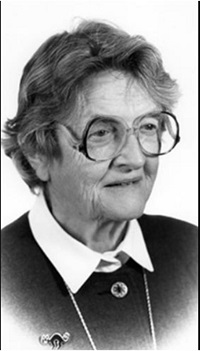
Lois Green Carr
Lois Green Carr, preeminent historian of colonial Maryland, died peacefully at her home on June 28, 2015. She was 93. Born on March 7, 1922, in Holyoke, Massachusetts, to Donald Ross Green and Constance McLaughlin Green, Carr was a third-generation historian. After graduating from Swarthmore College in 1943, she obtained her MA from Radcliffe College in 1944. In 1968, she earned her PhD in history from Harvard University. Her dissertation, County Government in Maryland, was perhaps the lengthiest (more than 1,000 typed pages) and most detailed study of local colonial government.
After moving to Annapolis in 1954, Carr joined the Hall of Records (now the Maryland State Archives) staff as a junior archivist in 1956. In 1967, she became historian of Historic St. Mary’s City (HSMC), a position she retained for 45 years. She continued to work primarily at the state archives, where she had ready access to the documentary records vital to her research. Carr founded the research program at HSMC, helped develop every exhibit at the museum (including numerous 17th-century reconstructions), and provided the key historical evidence for identifying the Calvert family members buried in lead coffins under the 1660s Brick Chapel. She had perhaps the greatest role in creating the Godiah Spray Tobacco Plantation, based directly on the research later published as Robert Cole’s World.
Internationally recognized as a leading social and economic historian of the colonial Chesapeake region, Carr coauthored and contributed to many books, articles, and papers, including Robert Cole’s World: Agriculture and Society in Early Maryland;Maryland’s Revolution of Government 1689–1692; Colonial Chesapeake Society; and Maryland: A New Guide to the Old Line State. As HSMC’s first historian, Carr undertook original research on a broader range of subjects than professional historians typically address. She believed that public history museums should offer interpretations adhering to the same high standards for quality and originality as leading academic institutions. As a result, a number of the research reports she produced for HSMC became the basis for books and articles, making major contributions to the fields of political, social, economic, and women’s history.
Although modest about her own achievements, Carr was widely recognized and admired by her colleagues. She was president of the Economic History Association in 1990–91. A conference in her honor, held in 1992 at the University of Maryland at College Park, brought together leading colonial scholars whom she had known and worked with during her career. In 1995, the HSMC awarded her its highest award, the Cross Bottony, and she was one of the first two recipients in 1996 of the Maryland Humanities Council’s Eisenberg Prize for Excellence in the Humanities. In 2000, Carr was inducted into the Maryland Women’s Hall of Fame, and in 2001, she received an honorary degree from St. Mary’s College of Maryland. Her coauthored volume Robert Cole’s World received numerous awards. Today, many of the articles and books she helped produce remain essential reading for all scholars of early American history.
Carr’s intellectual creativity and enthusiasm attracted quite a number of young researchers to the study of colonial Maryland history, a group often characterized as the “Maryland Mafia.” Her passion was to write and teach history for a broad public audience through museum programs rather than in an academic institution, but through her generous mentorship, Carr played a major role in shaping research, writing, teaching, and interpreting the history of the region. A demanding critic, Carr pushed scholars to aspire to high levels of achievement.
She was a pioneer in the field of colonial history, especially in the use of probate records to reveal the contours of the lives of ordinary as well as prominent people of the past. Her methodology—integrating archival research with archaeology and architecture—was considered novel when she initiated it. And she was in the forefront of using computers to manage and analyze large amounts of historical data. Carr designed and directed several long-term team history research projects that won support from the National Science Foundation and the National Endowment for the Humanities. Notably, Carr and her HSMC project colleagues produced “career files” documenting every known 17th-century St. Mary’s resident.
Carr served as a senior adjunct scholar at the Maryland State Archives from 1988 until 2005. In 1989, she assumed the position of senior historian of the Maryland Historic Trust, continuing to focus her work on St. Mary’s City, an activity she sustained even after her retirement in November 2005. She was an adjunct professor of history at the University of Maryland at College Park from 1982 until her retirement and a visiting professor at St. Mary’s College of Maryland in 1971.
In addition to her passion for history, Carr loved her Quarter Landing neighborhood, listening to classical music, gardening, cooking, entertaining guests, and participating in a play-reading group with her husband, Jack Ladd Carr, who preceded her in death in 2010. The couple regularly attended Annapolis Symphony Orchestra concerts and Colonial Players productions. Visiting colleagues always received a warm welcome at her home, and Annapolis friends gathered at her annual Christmas party.
Carr is survived by her only child, Andrew Clark, of Baltimore, Maryland; a nephew, Mitchell Green, of Washington state; and a niece, Alice Green, of California. She leaves behind many friends and colleagues who loved, respected, and admired her for the work that contributed so much to our understanding of early Maryland.
John McCusker
Trinity University
This work is licensed under a Creative Commons Attribution-NonCommercial-NoDerivatives 4.0 International License. Attribution must provide author name, article title, Perspectives on History, date of publication, and a link to this page. This license applies only to the article, not to text or images used here by permission.